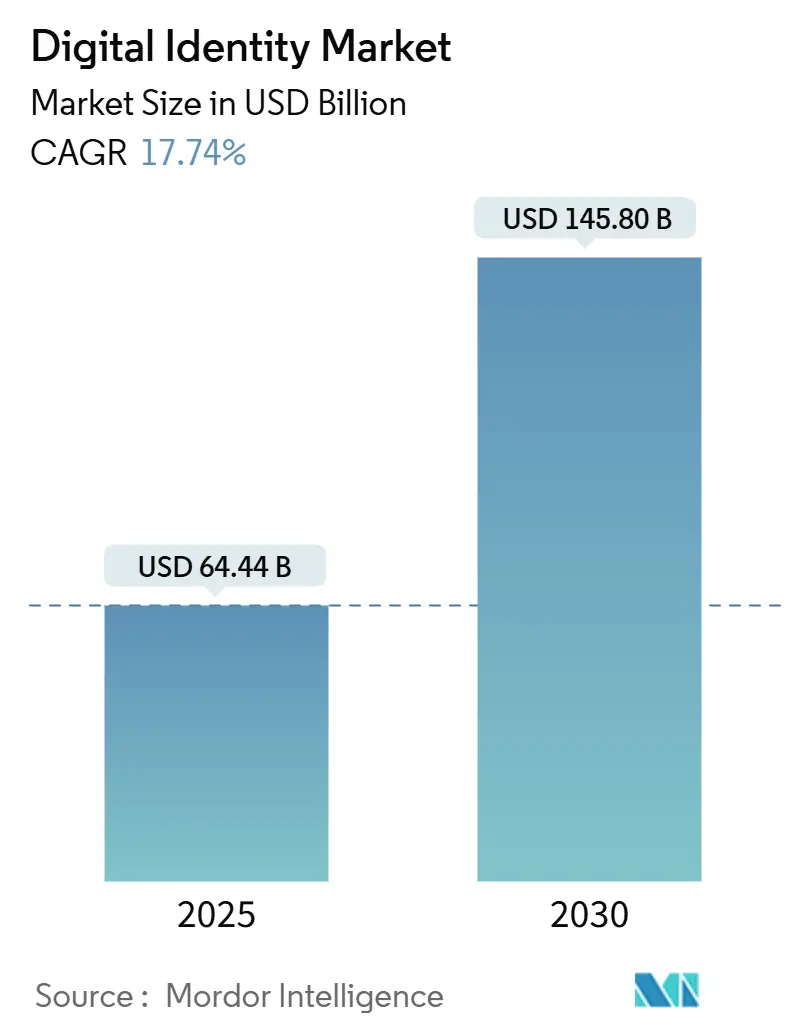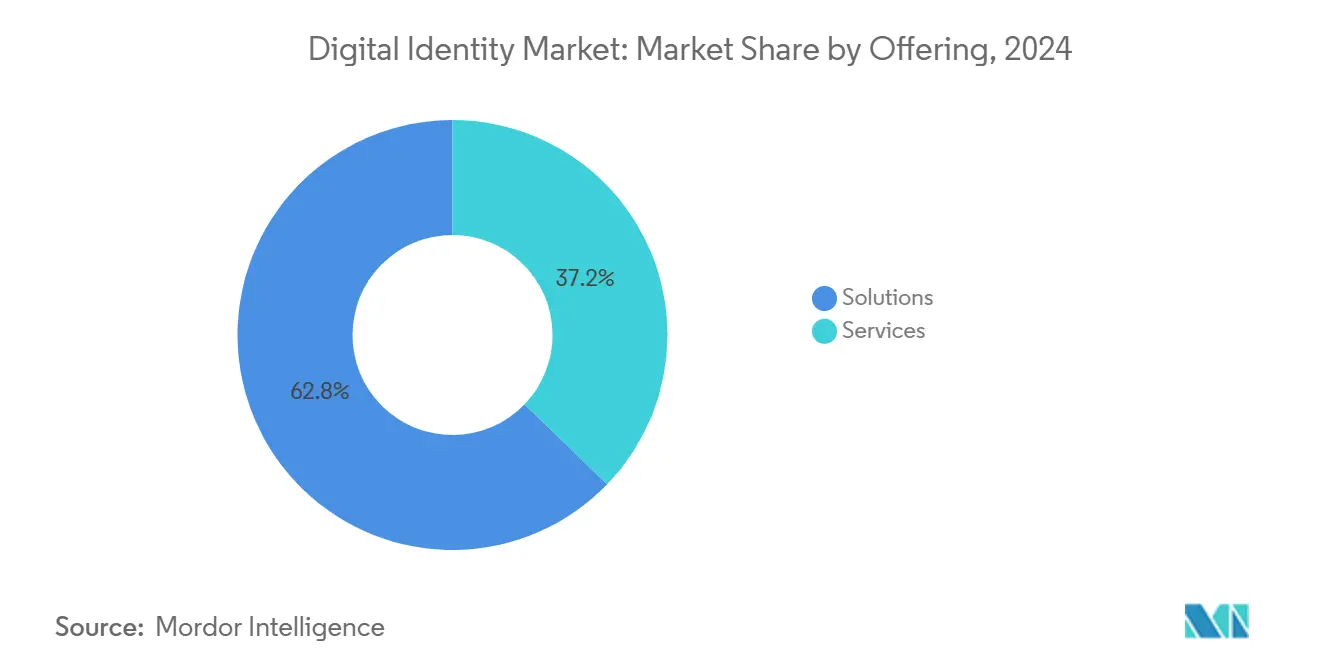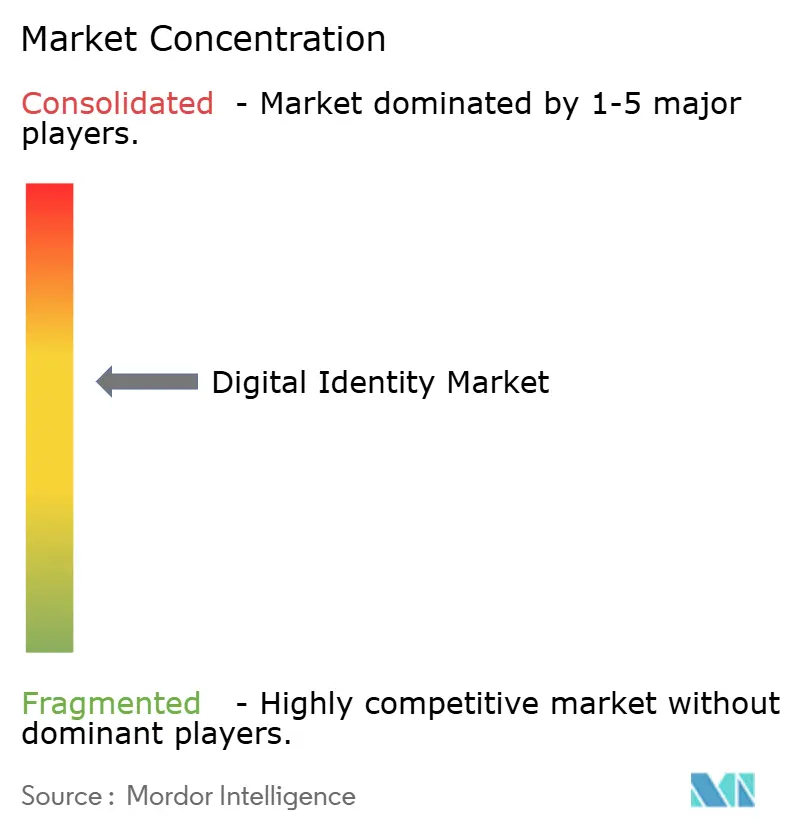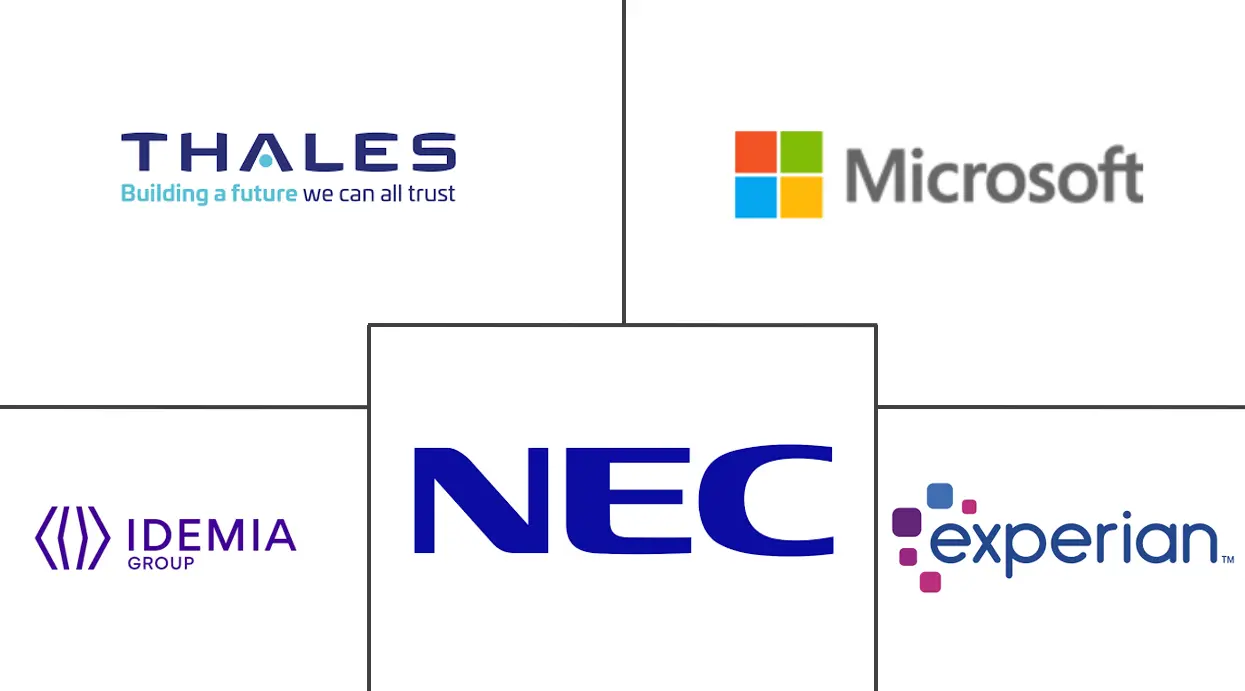Digital Identity Market Size and Share

Digital Identity Market Analysis by Mordor Intelligence
The digital identity market stands at USD 64.44 billion in 2025 and is forecast to reach USD 145.80 billion by 2030, expanding at a 17.74% CAGR. Growth is propelled by government-mandated identity wallets, rapid cloud adoption, and firm-level urgency to fight AI-enabled fraud. National ID programs across Asia-Pacific and Europe’s eIDAS 2.0 framework are setting global technical baselines, while biometric authentication gains momentum in retail and payments. Enterprises are modernizing identity stacks to meet zero-trust requirements, and regulators are moving toward real-time KYC as synthetic identities erode confidence in legacy checks. Together, these forces are accelerating platform consolidation and favoring vendors that bundle verification, authentication, and user lifecycle governance into one architecture.
Key Report Takeaways
- By offering, solutions led with 62.80% revenue share in 2024; services are advancing at a 20.60% CAGR through 2030.
- By deployment mode, cloud captured 71.60% of the digital identity market share in 2024, although hybrid and edge options are projected to grow at 2.80% CAGR.
- By end-user enterprise size, large enterprises accounted for 58.50% of the digital identity market size in 2024, while SMEs are expanding at 19.10% CAGR to 2030.
- By end-user industry, BFSI held 28.80% of 2024 revenue, whereas retail and e-commerce is forecast to record 22.10% CAGR.
- By geography, North America commanded 36.50% of 2024 revenue; Asia-Pacific is registering the fastest 24.50% CAGR.
Global Digital Identity Market Trends and Insights
Drivers Impact Analysis
| Driver | (~) % Impact on CAGR Forecast | Geographic Relevance | Impact Timeline |
|---|---|---|---|
| Proliferation of national ID-wallet programs (eIDAS 2.0, mDLs) | +4.2% | Europe, North America, Asia-Pacific core | Medium term (2-4 years) |
| Heightened KYC/AML compliance amid record online fraud | +3.8% | Global, with concentration in BFSI hubs | Short term (≤ 2 years) |
| Cloud-first CIAM adoption under zero-trust architectures | +3.1% | North America and EU, spill-over to Asia-Pacific | Medium term (2-4 years) |
| Expansion of mobile biometrics in payment and fintech apps | +2.9% | Global, early gains in Asia-Pacific | Short term (≤ 2 years) |
| Government push for digitised G2P cash-transfer rails | +2.4% | Asia-Pacific core, MEA, Latin America | Long term (≥ 4 years) |
| Verifiable-credential demand in B2B supply-chain audits | +1.4% | Global, manufacturing corridors | Long term (≥ 4 years) |
| Source: Mordor Intelligence | |||
Proliferation of National ID-Wallet Programs (eIDAS 2.0, mDLs)
Mandatory digital wallets are reshaping the digital identity market by creating common standards for high-assurance credentials. The European Union requires every member state to issue an interoperable wallet by December 2026, and regulated industries must accept it by November 2027. Adoption targets of 80% by 2030 illustrate how policy can spur network effects that benefit private platforms as well. Parallel momentum exists in the United States, where the TSA is rolling out mobile driver’s license acceptance across airports, giving millions of travelers day-to-day exposure to biometric-backed credentials and setting the stage for private-sector reuse.
Heightened KYC/AML Compliance Amid Record Online Fraud
Financial institutions faced an 86% identity-based attack rate in 2024 [1]HYPR Labs, “2024 State of Passwordless Security Report,” hypr.com. The rise of AI-generated synthetic IDs is forcing a shift from document checks alone to layered verification that mixes computer-vision, behavioral analytics, and passkeys. Continuous risk monitoring is replacing point-in-time checks, driving sustained demand for adaptive orchestration engines. Passwordless FIDO standards also cut friction, improving onboarding conversion rates while meeting stronger due-diligence expectations.
Cloud-First CIAM Adoption Under Zero-Trust Architectures
Organizations are consolidating fragmented directories into cloud CIAM platforms that fit zero-trust blueprints. Microsoft measured that only 2% of permissions are actually used, highlighting vast over-provisioning. Unified identity fabrics reduce that exposure, secure both human and workload identities, and integrate verifiable credentials for minimal personal-data storage. Enterprises gain operational relief because AI-driven decisioning automates entitlement clean-up, especially across multicloud estates.
Expansion of Mobile Biometrics in Payment and Fintech Apps
Face and palm verification are moving from pilot to mainstream as retailers race to contain deepfake fraud. JPMorgan Chase plans to enable biometric checkout in US stores in 2025, in a payments segment projected to reach USD 5.8 trillion with 3 billion users by 2026. Localized processing and template encryption address privacy concerns, turning biometrics into both a security control and a customer-experience differentiator during checkout.
Restraints Impact Analysis
| Restraint | (~) % Impact on CAGR Forecast | Geographic Relevance | Impact Timeline |
|---|---|---|---|
| Persistent privacy and data-breach concerns | -2.7% | Global, heightened in EU and North America | Short term (≤ 2 years) |
| Regulatory and standards fragmentation across regions | -1.9% | Global, cross-border operations | Medium term (2-4 years) |
| Deep-fake driven synthetic-ID false-reject spiral | -1.4% | Global, concentrated in high-value sectors | Short term (≤ 2 years) |
| Scarcity of decentralised-ID cryptography talent | -1.1% | Global, acute in emerging markets | Long term (≥ 4 years) |
| Source: Mordor Intelligence | |||
Persistent Privacy and Data-Breach Concerns
Rigorous privacy laws are raising compliance costs and slowing adoption in the digital identity market. The GDPR sets the global benchmark, yet uneven enforcement across jurisdictions complicates multinational rollouts. Healthcare illustrates the tension as providers must secure patient portals and meet HIPAA rules while cybercriminals target help desks through voice phishing. Firms are testing self-sovereign models with zero-knowledge proofs, but these approaches demand cryptographic skills and infrastructure that many organizations lack.
Deepfake-Driven Synthetic-ID False-Reject Spiral
As detection checks toughen, legitimate users risk being incorrectly rejected, eroding trust and conversions. Institutions are experimenting with behavioral signals such as mouse dynamics and liveness scoring to lower friction, yet these mechanisms require significant data volumes that may conflict with regional data-minimization rules. Balancing security and usability remains a core inhibitor until detection algorithms advance further.
Segment Analysis
By Offering: Solutions Drive Market Foundation
Solutions sustained a 62.80% share of the digital identity market in 2024, anchored by platforms that fuse authentication, authorization, and governance into one stack. Vendors expand scope beyond workforce log-ins to cover APIs, service accounts, and machine identities, ensuring consistent policies across hybrid clouds. Microsoft’s Entra upgrade illustrates this evolution, merging permissions, workload identities, and governance into a single control plane. Services are rising faster, clocking 20.60% CAGR from 2025 to 2030 as implementation complexity creates skills gaps. Providers deliver audits, migration roadmaps, and managed operations so customers can achieve compliance without scaling internal teams.
Services growth signals a shift from product procurement to outcome-driven engagements. Identity-as-a-service contracts with defined SLAs gain traction among mid-market companies seeking predictable costs and turnkey integrations. Partnerships between platform vendors and global system integrators accelerate sunset of legacy LDAP directories and smart-card infrastructures. As a result, the digital identity market size attached to professional and managed services is projected to capture an increasing slice of total spending through 2030.

Note: Segment shares of all individual segments available upon report purchase
By Deployment Mode: Cloud Maturation Drives Hybrid Adoption
Cloud remained dominant with 71.60% revenue in 2024, yet its annual growth eases to 2.80% as enterprises blend on-prem and edge nodes for latency and residency reasons. Sovereign-cloud mandates in the EU and data-localization rules in India prompt re-evaluation of lift-and-shift strategies. Identity platforms respond by delivering federated brokers that normalize authentication flows across Kubernetes clusters, private data centers, and SaaS tenants. This orchestration lets administrators enforce least-privilege principles consistently regardless of hosting model, reinforcing the digital identity market’s resilience to deployment shifts.
Edge authentication marks a third paradigm where biometrics and crypto keys validate users or devices locally, shrinking attack surfaces. Payment terminals and IoT gateways perform liveness checks without round-trip latency, then propagate signed tokens into the wider trust fabric. Vendors are already integrating post-quantum algorithms so credentials minted at the edge remain secure beyond 2030. The digital identity market size for edge-centric solutions is modest today but carries outsize strategic significance as 5G and private-LTE networks proliferate.
By End-User Enterprise Size: SME Growth Accelerates
Large enterprises held 58.50% revenue in 2024 by virtue of complex estates and mandatory governance frameworks. Still, SMEs are recording 19.10% CAGR because cloud subscription models strip away entry barriers. Off-the-shelf blueprints let smaller banks satisfy KYC rules and retailers adopt passwordless log-ins without building custom stacks. Okta’s venture program, which commits up to USD 500,000 for identity-security startups, exemplifies ecosystem investment that tailors services to SME budgets.
SaaS subscription tiers map pricing to active users, aligning with fluctuating SME headcount and seasonal demand. Embedded identity APIs inside e-commerce platforms mean merchants can enable document scanning or face verification in minutes. Consequently, the digital identity market expands depth-wise into long-tail customers rather than only landing marquee enterprise logos. Providers thus refine go-to-market motions around automated trials and self-service onboarding that resonate with resource-constrained buyers.

Note: Segment shares of all individual segments available upon report purchase
By End-User Industry: Retail E-Commerce Transformation
BFSI retained 28.80% of 2024 spending due to stringent capital-markets rules, multi-factor authentication mandates, and the direct monetary impact of account takeover. Banks refresh mainframe IAM stacks and overlay passkeys alongside behavioral analytics to mitigate an 86% attack incidence rate. Retail and e-commerce grow at 22.10% CAGR as merchants strive for one-tap checkout experiences while blocking refund fraud and promo abuse. Biometric payment rails meet liability-shift requirements and lower cart abandonment, embedding identity deep into commerce funnels.
Government programs drive another wave as public-service portals consolidate disparate log-ins under national wallets. Indonesia’s Digital Population Identity initiative, covering more than 200 million citizens, illustrates population-scale issuance. Healthcare adopts unique patient identifiers to improve match rates for tele-consultations while safeguarding PHI. Manufacturing and telecom players deploy verifiable credentials to secure device boards and supply-chain attestations, broadening the digital identity industry use cases beyond human users.
Geography Analysis
North America held 36.50% of 2024 revenue, anchored by mature enterprise adoption and supportive federal guidance. The TSA’s expansion of mobile driver’s licenses across airports normalizes wallet presentation in daily life, while JPMorgan Chase’s biometric payment rollout signals private-sector validation of high-assurance methods. Yet fragmented state standards create integration friction for businesses operating across the United States and Canada, prompting federated architectures that respect diverse assurance levels.
Asia-Pacific is the fastest mover with 24.50% CAGR. Population-scale initiatives in Indonesia, Malaysia, and Vietnam leapfrog incremental rollouts seen elsewhere. Australia’s Digital ID Act 2024 earmarks USD 288 million to accredit providers and build privacy safeguards [2]Australian Department of Finance, “Digital ID Act 2024 Overview,” finance.gov.au. Regional consortia are aligning QR-based payment identity with travel credentials to enable cross-border authentication, accelerating the digital identity market’s network effect across ASEAN and Oceania.
Europe advances through regulatory harmonization. eIDAS 2.0 sets legal grounds for mutual recognition, enabling a citizen in Germany to access services in Spain using the same wallet [3]European Commission, “European Digital Identity Framework,” ec.europa.eu. Member states invest in high-assurance schemes such as France’s digital ID card and the UK’s GOV.UK Wallet mobile application. Latin America, the Middle East, and Africa witness progressive uptake as mobile penetration enables leapfrog identity rails that support remittances and social-benefit disbursement, though funding gaps and skills shortages slow full-fidelity deployments.

Competitive Landscape
The digital identity market shows moderate fragmentation with nascent consolidation. Top platforms pursue inorganic growth to assemble verification, biometrics, and governance modules under one roof. IN Groupe’s EUR 1 billion acquisition of IDEMIA Smart Identity exemplifies the scale required to compete globally. Buyers favor suites that address both workforce and customer use cases, creating pressure on niche point products to merge or differentiate via vertical expertise.
Technology rivalry centers on AI-driven risk engines, multimodal biometrics, and post-quantum readiness. Vendors invest in neural networks that detect deepfakes and suspicious behavioral patterns in real time. Partnerships multiply: iProov and TrustCloud embed quantum-safe encryption alongside facial liveness, while Okta collaborates with cloud providers to extend single-token sign-on across SaaS ecosystems. Open-source verifiable-credential stacks are also maturing, giving system integrators alternative toolkits to avoid vendor lock-in.
Start-ups focus on domain-specific gaps such as healthcare patient matching and supply-chain credentials for ESG audits. However, scaling these solutions requires integration into larger ecosystems, triggering strategic investments from incumbents. Over the forecast period, competitive intensity will hinge on the speed at which vendors can embed privacy-preserving analytics and comply with region-specific assurance frameworks while maintaining seamless user experience.
Digital Identity Industry Leaders
-
IDEMIA Group
-
NEC Corporation
-
Thales Group
-
Experian plc
-
Microsoft Corporation
- *Disclaimer: Major Players sorted in no particular order

Recent Industry Developments
- May 2025: Worldcoin launched its biometric identity verification system in the United States, deploying 7,500 Orb Mini devices across six cities with partners including Visa and Match Group.
- April 2025: Okta unveiled new platform capabilities that secure AI agents and other non-human identities inside business workflows.
- January 2025: The United Kingdom government released a GOV.UK Wallet app on iOS and Android, offering digital driving licenses and other documents.
- January 2025: IDEMIA secured a 10-year blanket purchase agreement from the US General Services Administration to supply next-generation identity proofing for Login.gov.
Research Methodology Framework and Report Scope
Market Definitions and Key Coverage
Our study defines the digital identity market as every software platform, hosted service, and supporting consultancy that captures, verifies, federates, and governs a digital record of a person, entity, or connected device across cloud, on-premise, and hybrid environments. According to Mordor Intelligence, value is tracked only where identity creation or verification is the primary revenue driver, expressed in USD.
Scope exclusion: single-purpose password managers, stand-alone physical access badges, and hardware tokens shipped without identity-orchestration logic are not counted.
Segmentation Overview
- By Offering
- Solutions
- Services
- By Deployment Mode
- Cloud
- On-premise
- By End-user Enterprise Size
- Small and Medium Enterprises
- Large Enterprises
- By End-user Industry
- BFSI
- Government and Public Services
- IT and Telecom
- Retail and E-commerce
- Manufacturing
- Healthcare
- Other Industries
- By Geography
- North America
- United States
- Canada
- Mexico
- South America
- Brazil
- Argentina
- Rest of South America
- Europe
- Germany
- United Kingdom
- France
- Italy
- Spain
- Russia
- Rest of Europe
- Asia-Pacific
- China
- Japan
- India
- South Korea
- Australia and New Zealand
- Rest of Asia-Pacific
- Middle East and Africa
- Middle East
- Saudi Arabia
- United Arab Emirates
- Turkey
- Rest of Middle East
- Africa
- South Africa
- Nigeria
- Egypt
- Rest of Africa
- Middle East
- North America
Detailed Research Methodology and Data Validation
Primary Research
Mordor analysts interviewed senior architects in banks, national ID program officers, telecom identity heads, and SaaS CISOs across North America, Europe, the Gulf, and ASEAN. These conversations clarified average verification fees, adoption timelines, and post-implementation churn, allowing us to reconcile gaps spotted in public data.
Desk Research
We began with policy and statistical repositories such as NIST Digital Identity Guidelines, the World Bank ID4D Atlas, EU eIDAS 2.0 regulatory dossiers, ITU ICT penetration data, and BIS cyber-risk bulletins, followed by company 10-Ks, investor decks, and association portals (FIDO Alliance, EuroSmart, OpenID Foundation). Subscription feeds from D&B Hoovers and Dow Jones Factiva helped us capture vendor-level revenue shifts and contract wins. These references illustrate, not exhaust, the evidence base that grounds our desk work.
Market-Sizing & Forecasting
We start top-down by reconstructing spend from verified-user pools: active e-government IDs, digital banking customers, and remote-KYC onboarding volumes, filtered through typical price-per-check and wallet-maintenance fees. Supplier roll-ups and sampled ASP × transaction counts provide bottom-up cross-checks before totals are locked. Key variables modeled include national ID-wallet rollout deadlines, fraud-loss ratios, biometric sensor attach rates, cloud CIAM seat growth, and regulatory audit frequency. A multivariate regression blended with ARIMA handles the five-year outlook; scenario pivots adjust for compliance lags or macro-credit shocks. Where bottom-up evidence is thin, weightings are prorated using nearest proxy markets validated by our respondents.
Data Validation & Update Cycle
Outputs pass variance screens versus payment-fraud losses, smartphone shipments, and vendor bookings. Senior reviewers rerun anomaly flags, and we refresh every twelve months or sooner if material events, such as new eID mandates, shift baselines. A final pre-publication sweep ensures clients receive the most current view.
Why Mordor's Digital Identity Baseline Commands Confidence
Published estimates often diverge because each firm picks a different mix of solutions, pricing ladders, and refresh cadences.
Key gap drivers include: some studies focus only on software subscriptions, others bundle hardware readers; a few rely on historical CAGR extrapolation without primary validation; currency conversions vary, and refresh cycles stretch to three years, whereas Mordor revisits data annually.
Benchmark comparison
| Market Size | Anonymized source | Primary gap driver |
|---|---|---|
| USD 64.44 B (2025) | Mordor Intelligence | |
| USD 47.02 B (2025) | Global Consultancy A | Excludes on-premise services, limited expert interviews |
| USD 42.12 B (2024) | Industry Association B | Earlier base year, hardware weighting diluted, top-down only |
| USD 33.36 B (2025) | Regional Consultancy C | Conservative adoption scenario, revenue roll-ups by broad ICT buckets |
The comparison shows that when scope, price points, and validation depth are fully aligned, our figures sit mid-band, offering decision-makers a balanced, traceable baseline they can defend in board discussions and budget cycles.
Key Questions Answered in the Report
What is the current value of the digital identity market and how fast is it growing?
The market is valued at USD 64.44 billion in 2025 and is projected to expand to USD 145.80 billion by 2030, reflecting a 17.74% CAGR.
Which regions are driving the fastest growth in digital identity adoption?
Asia-Pacific is leading with a 24.50% CAGR, fueled by government-backed national ID programs and large-scale population rollouts.
Why are financial institutions investing heavily in digital identity solutions?
Banks face an 86% identity-based attack rate, so they are adopting layered authentication—document checks, biometrics, and passkeys—to meet stricter KYC/AML demands and curb synthetic-ID fraud.
How are small and medium enterprises benefiting from digital identity platforms?
Cloud-based identity-as-a-service options let SMEs access enterprise-grade security without large upfront investments, propelling 19.10% CAGR in the SME segment through 2030.
What role does eIDAS 2.0 play in shaping the European digital identity landscape?
The regulation requires all EU member states to issue interoperable digital identity wallets by December 2026, standardizing cross-border verification and accelerating private-sector acceptance.
Which industry segment is expected to grow the fastest through 2030?
Retail and e-commerce is projected to advance at a 22.10% CAGR as merchants integrate biometric payment authentication to reduce checkout fraud and improve customer experience.
Page last updated on:



